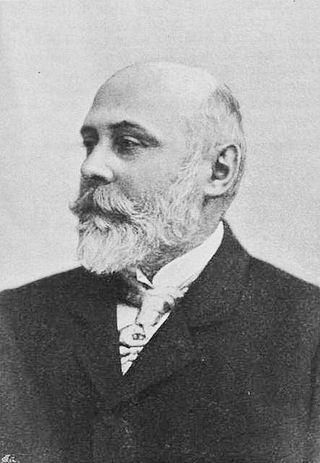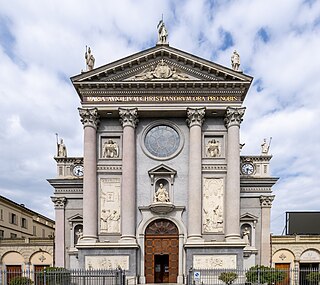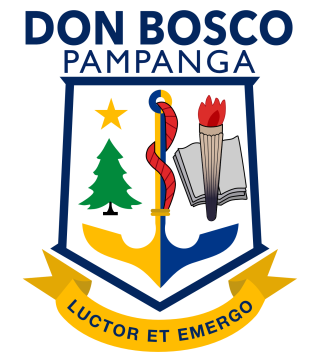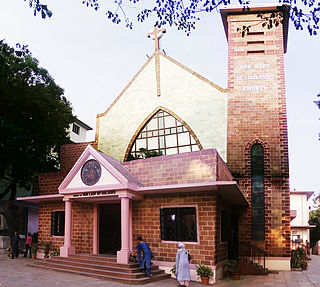
The Salesians of Don Bosco (SDB), formally known as the Society of Saint Francis de Sales, is a religious congregation of men in the Catholic Church, founded in 1859 by the Italian priest John Bosco to help poor and migrant youngsters during the Industrial Revolution. The congregation was named after Francis de Sales, a 17th-century bishop of Geneva.

John Melchior Bosco, SDB, popularly known as Don Bosco, was an Italian Catholic priest, educator and writer. While working in Turin, where the population suffered many of the ill effects of industrialization and urbanization, he dedicated his life to the betterment and education of street children, juvenile delinquents, and other disadvantaged youth. He developed teaching methods based on love rather than punishment, a method that became known as the Salesian Preventive System.

Don Bosco Technical Institute in Tarlac City, or simply Don Bosco Tarlac, is a private Catholic school for pre-school, grade school and junior high school boys. In 2016, it opened its co-educational senior high school department. The first Don Bosco school in the Philippines, it is the only academic-technical school in Tarlac. Its campus is located in Sto. Cristo, Tarlac City, Philippines.

Ödön Lechner was a Hungarian architect, one of the prime representatives of the Hungarian Szecesszió style, which was related to Art Nouveau in the rest of Europe, including the Vienna Secession. He is famous for decorating his buildings with Zsolnay tile patterns inspired by old Magyar and Turkic folk art, which are combined with modern materials such as iron.

The Basilica of Our Lady Help of Christians is a Pontifical church and Marian shrine in Turin, Italy. The building was originally part of the safehouse for poor boys cared for by Don Bosco, it now contains the remains of Bosco, and six thousand numbered relics of other Catholic saints.
St. Anthony’s Higher Secondary School, is an educational institution of the Catholic Church, belonging to and managed by the Salesians of Don Bosco Educational Society .Guided by the religious and educational philosophy of St. John Bosco, the school was founded to bring school education within the reach of the common man.
Don Bosco Formation Center (DBFC), formerly known as Don Bosco Missionary Seminary (DBMS), is a Salesian House run by the Salesians of Don Bosco (SDB) in Lawaan III Talisay City, Cebu, Philippines. It was established to provide salesian formation for the candidates to the priestly and religious life of the Salesian Province of Mary Help of Christians (FIS) in the Philippines.

Don Bosco Academy also referred to by its acronym DBA or Don Bosco Pampanga" is a private Catholic Salesian technical educational institution for boys run by the Salesians of the Society of Saint John Bosco in Bacolor, Pampanga, Philippines. It was founded in 1956 by the (Salesians).

Carlo Braga was a Salesian religious priest. He is also sometimes known as "the little Don Bosco of China" for his missionary works towards the children in China. He died in the Philippines in 1971.

Giuseppe Moja was a Salesian priest and missionary in India. He is part of the group of pioneers who began the Salesian work in Panjim, Goa, including the Don Bosco High School, Panjim. He also pioneered the Salesian work in Sulcorna, Goa, where there is now a substantial farm and the Don Bosco High School, Sulcorna.
The sexual abuse scandal in the Salesian Order is a major chapter in the series of Catholic sex abuse cases in various Western jurisdictions.

Louis Mathias was the first Catholic bishop of Shillong who later became the Archbishop of the Roman Catholic Archdiocese of Madras and Mylapore (1935-1952). He belonged to Salesian congregation and came as a missionary to India.

Don Bosco Technical High School was an all-boys Roman Catholic secondary school for grades 9 through 12 in Boston, Massachusetts, United States. It was founded in 1946 as a school for immigrant boys by the Salesians of Don Bosco, a religious order of priests and brothers. It closed in 1998.

The Church of Our Lady of Dolours, Wadala is a Roman Catholic church in Mumbai, India built in 1853. The parish of Our Lady of Dolours with its school, St. Joseph's was entrusted to the Salesians in 1948, about the same time as the Salesians settled in Matunga. The school was co-ed until the Salesian Sisters came into the Wadala Village with the Auxilium Convent for girls. The centerpiece of the church is a statue of the Pieta.

István Sándor was a Hungarian Salesian and labourer, martyr and Blessed.
José Vandor Puchner – born as József Wech – was a Hungarian Roman Catholic priest and a professed member from the Salesians of Don Bosco. He served in the missions on the island nation of Cuba where he was stationed from 1936 until his death but spent the bulk of that time in Santa Clara where he was since 1954.
Dezső Magos was a Jewish-Hungarian architect. He was born in Balassagyarmat, in what is now Hungary.

Pascual Chávez Villanueva SDB is a Roman Catholic priest of the Salesians of Don Bosco, who was Rector Major of that Order between April 3, 2002 and March 25, 2014, being the 9th successor of Don Bosco, the first Mexican to get such position and the second Latin American after Argentinian Juan Edmundo Vecchi. During the 26th General Chapter of the Salesians in Rome in 2008 he was confirmed for a second period, being the last Rector Major who could be reelected, because that same Chapter ruled that a Rector Major would not be reelected afterward.

János Brenner, O.Cist was a Hungarian Catholic priest and member of the Cistercian Order. Brenner studied for the priesthood during a period of communist persecution of religious orders. Communist authorities came to suspect him of being critical of their regime; his success as a youth chaplain made him a threat. As a consequence, he was murdered by hired men who stabbed him 32 times and inflicted severe wounds to his head using canes. He died soon after having been hurled into a ditch in the woods. The beatification took place on 1 May 2018 in Szombathely.

István Seregély was a Hungarian prelate of the Roman Catholic Church, who served as Archbishop of Eger from 5 June 1987 to 15 March 2007.














